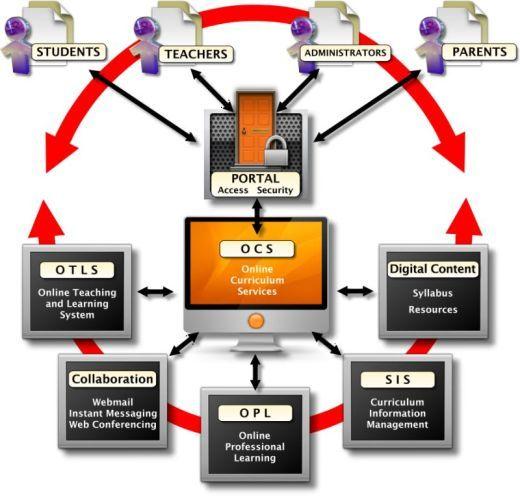Networked Learning (Stage 4)
The Austrian education system, with mandatory learning for children, began in 1775 initiated by the Empress Maria Theresa. Originally, children were required to attend school from the ages of six to twelve where there were given a general education; however, only the wealthy were able to afford continuing education. An exclusionary requirement was created to separate the classes where at the age of ten, children were made to commit to an eight year secondary education of general (university prep) classes or a two to four year commitment for vocational training. Since most families were unable to afford the wait for their children to be financially aiding the family, this track system excluded most of the populace continuing until 1962 when the School Act was put into place. This took away the inflexibility of the previous system and opened up the country to begin improving its educational standing.(1)
Now from the age of six until fifteen, all students are required
to attend primary and secondary schools and then may attend
either vocational or university preparatory tracks from one to
four years after that. While the need to decide at an early age
the area of focus for a student (at age ten), the Federal
Ministry of Education, Science, and Cultural Affairs (which had
taken over control of most educational areas by 2001) has been
working to break down qualification barriers for entrance into
the varying secondary schools to advance flexibility for
students and encouragement to enroll in higher science,
mathematics, and technological fields of study. With these
changes, as well as minimal fees necessary during the education
process (only University study has a cost per term of €366), the
number of students attending higher education has increased
significantly especially since 2000 when ICT training began to
be incorporated into the general education format. A continuing
area of concern for the Austrian Ministry is the inequality of
gender education which still persists especially in the
encouraged technical fields of study which will be discussed
further in the final section(3).
Education Table.

School Access to Information and Communication Technologies (Stage 4)
At the forefront of the Ministry of Education policies during the 2000s was to insure a high level of ICT access and development to improve and enhance the overall educational system within Austria (this does not include approximately 10% of primary and secondary schools which are private and mostly maintained by the Roman Catholic Church). Not only were these enhancements focused on school connectivity but also to promote the early adoption of technological acceptance by the students. During this period all school locations were networked by broadband access and alternative programs around e-learning and blended learning were added to create a flexible future looking educational system towards initial and continuing education programs.4 This access helped to bridge the gap for private broadband access which had been slower to develop until federal province initiatives were enacted.
Not only was access to the network mandated by the Ministry of Education, several key programs were developed to improve training and understand of the technology for teachers and school principals. Teachers were given extensive training in ICT skills by enrolling them in the European Computer Driving License (ECDL) program which focuses on the following objectives5:
- Increase productivity and save time
- Enhance communication
- Track and monitor student attendance and performance
- Improve digital literacy skills increases teacher productivity
- Access, share, create, and reuse online lesson plans and educational content
- Access multimedia and interactive content to support learning
- Accommodate different learning styles and abilities by varying content
- Increase student motivation through the use of ICT in the classroom
- Share best practices online and increase collaboration within and between schools
- Communicate with students using email, instant messaging or blogs
- Share curriculum plans with colleagues and staff
Standardization of ICT access and facilities as well as mandate for schools to join into the various e-learning and communication programs enhanced the access to the technology needed for a wide spread change in the overall ICT educational structure. These mandates continue today by strength of a unified set of rules placed on all educational institutions which creates a community for technological achievement.
Enhancing Education with ICTs (Stage 4)
Starting with the eFit Strategy in 2000, Austria worked diligently over the past decade to increase its ICT literacy and access for both children and adults. This was based in part on working towards the Lisbon Strategy which was an action and development plan for the European Union economic development started in March 2000.6 eFit had three development stages used to improve education for all Austrians during this time
(7):
- eFit 2000 – focused on connectivity and networking the various educational institutions while improving the basic ICT skills of the populace
- eFit 2005 – provided the sustainability objectives needed to continue the progress made through infrastructure and e-media/e-literacy access.
- eFit 2007 – eFit was morphed into the “FutureLearning Strategy” to focus on educational creativity using ICT tools and adding the flexibility needed for students to chart their own course in learning.
Other e-learning was incorporated into the standard teaching methodology by the Ministry during the start of the 2005 school year. After pilot programs were developed in 2002 using the eLSA network for communication and knowledge sharing, the network was rolled out en masse to institutions to provide for an exchange platform of experiences and development for teachers and school principals to incorporate into students curricula.
Web 2.0 tools such as (wikis, blogs and edunoodle) were incorporated into the learning environment to enhance overall integration of the institutions and make available many license free platforms to students and faculty which were quickly incorporated into the classrooms by 2006 which increased collaboration and applied advanced software skills at early ages for students.
Developing The ICT Workforce (Stage 3/4)
PThe development of the ICT workforce has been a mixed endeavor for Austria, but a clear focus of their mission during the past decade. While there is evidence of a gap in skill sets between the students which went through the advancing ICT policy periods and the aging populace in general, the need to reach out to all Austrians is evident in the growth in training opportunities and network development from the Ministry.
The Federal Act on the Organisation of University Colleges of Teacher Education which was passed in March of 2006, moved the educational requirements of teachers from a college level to universities and enacted academic standards similar to those recognized in other countries to achieve a Bachelor level degree. In addition, technical curricula in other disciplines was standardized under School Instruction Act of 2008 and enhanced by the e-Learning Cluster creating a skills and knowledge certification program in platform options such as basic IT-Skills like the ECDL; alternative operating systems like LINUX; technical networking like CISCO-certificates; JAVA programmer; network operating systems like MCSE; specific ERP software like SAP/R3. Also non-mandatory promotion of advanced skills for students and didactic approaches for teachers to integrate real world occupational certificates in Advanced ECDL, network academy, ERP systems, open source knowledge, networking operation systems or script language(8).
Lastly, the Austrian Ministry has taken special steps to focus on the ICT development of its adult population by implementing the Austria’s Road to Employability – Caritas through the Caritas Europa program.9 In a partnership with Microsoft Europe, ICT training has been implemented focusing on disadvantaged communities and especially woman to create a knowledge education aimed at breaking the continuing cycle of poverty and an overall lack of skills within these groups. While many of these participants are immigrants, this incorporation of education to the impoverished is creating a new level of inclusion into the country’s mission for ICT skill training and education to be widely available.10 One area of concern outside of the Caritas program has been the overall lack of significant increase in participation of women in continuing and further education. While the female enrollment in higher education has increased, many areas of technical study (math, science, information technology, and engineering) are still male dominated and have not seen significant increase over the last ten years. Ways in combating this disparity have included focused education on female teachers in these disciplines to create a more supportive and mentoring atmosphere within educational and outreach programs.



